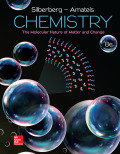
Concept explainers
(a)
Interpretation:
The highest frequency and minimum wavelength of radiation emitted when the electron makes a transition from
Concept introduction:
The difference between the energies of two energy levels is the amount of energy in a photon emitted or absorbed when an electron makes a transition. The energy of a photon emitted or absorbed by an electron is,
Here,
(a)
Answer to Problem 7.81P
The highest frequency of radiation emitted when the electron makes a transition from
Explanation of Solution
The energies of the energy levels 3 and 1 are
The formula to calculate the difference in the energies of energy level 1 and 2 is,
Substitute
Substitute
Rearrange the above equation to calculate the value for
The equation to relate the frequency and wavelength of radiation is as follows:
Substitute
Rearrange the above equation to calculate the value of
The highest frequency of radiation emitted when the electron makes a transition from
(b)
Interpretation:
The ionization energy of the atom in its ground state in
Concept introduction:
Ionization energy is defined as the amount of energy required to remove an electron from an isolated gaseous atom. The energy required to remove an electron from an atom depends on the position of the electron in the atom. The closer the electron is to the nucleus in the atom, the harder it is to pull it out of the atom. As the distance of an electron from the nucleus increases, the magnitude of the forces of attraction between the electron and the nucleus decreases. Thus it becomes easier to remove it from the atom.
(b)
Answer to Problem 7.81P
The ionization energy of the atom in its ground state in
Explanation of Solution
The total number of atoms in one mole of a compound is
The ionization energy required to remove an electron from the ground state is the same as the energy of the state.
Thus for one atom, the ionization energy for the ground state is
For 1 mole
The ionization energy of the atom in its ground state in
(c)
Interpretation:
The shortest wavelength of radiation that could be absorbed by the electron in the
Concept introduction:
Electromagnetic waves are radiations that are formed by oscillating electric and magnetic fields. The electric and magnetic field components of an electromagnetic wave are perpendicular to each other.
The difference between the energies of two energy levels is the amount of energy in a photon emitted or absorbed when an electron makes a transition. The energy of a photon emitted or absorbed by an electron is,
Here,
The equation to relate the frequency and wavelength of radiation is as follows:
The above relation can be modified as follows:
(c)
Answer to Problem 7.81P
The shortest wavelength of radiation that could be absorbed by the electron in the
Explanation of Solution
Since the absorption of radiation occurs, hence the electron from
The shortest wavelength of radiation will be absorbed for a transition from
The energy of the energy level 4 and 6 are
The formula to calculate the difference in the energies of energy level 4 and 6 is,
Substitute
Substitute
Rearrange the above equation to calculate the value of
The shortest wavelength of radiation that could be absorbed by the electron in the
Want to see more full solutions like this?
Chapter 7 Solutions
EBK CHEMISTRY: THE MOLECULAR NATURE OF
 ChemistryChemistryISBN:9781305957404Author:Steven S. Zumdahl, Susan A. Zumdahl, Donald J. DeCostePublisher:Cengage Learning
ChemistryChemistryISBN:9781305957404Author:Steven S. Zumdahl, Susan A. Zumdahl, Donald J. DeCostePublisher:Cengage Learning ChemistryChemistryISBN:9781259911156Author:Raymond Chang Dr., Jason Overby ProfessorPublisher:McGraw-Hill Education
ChemistryChemistryISBN:9781259911156Author:Raymond Chang Dr., Jason Overby ProfessorPublisher:McGraw-Hill Education Principles of Instrumental AnalysisChemistryISBN:9781305577213Author:Douglas A. Skoog, F. James Holler, Stanley R. CrouchPublisher:Cengage Learning
Principles of Instrumental AnalysisChemistryISBN:9781305577213Author:Douglas A. Skoog, F. James Holler, Stanley R. CrouchPublisher:Cengage Learning Organic ChemistryChemistryISBN:9780078021558Author:Janice Gorzynski Smith Dr.Publisher:McGraw-Hill Education
Organic ChemistryChemistryISBN:9780078021558Author:Janice Gorzynski Smith Dr.Publisher:McGraw-Hill Education Chemistry: Principles and ReactionsChemistryISBN:9781305079373Author:William L. Masterton, Cecile N. HurleyPublisher:Cengage Learning
Chemistry: Principles and ReactionsChemistryISBN:9781305079373Author:William L. Masterton, Cecile N. HurleyPublisher:Cengage Learning Elementary Principles of Chemical Processes, Bind...ChemistryISBN:9781118431221Author:Richard M. Felder, Ronald W. Rousseau, Lisa G. BullardPublisher:WILEY
Elementary Principles of Chemical Processes, Bind...ChemistryISBN:9781118431221Author:Richard M. Felder, Ronald W. Rousseau, Lisa G. BullardPublisher:WILEY





